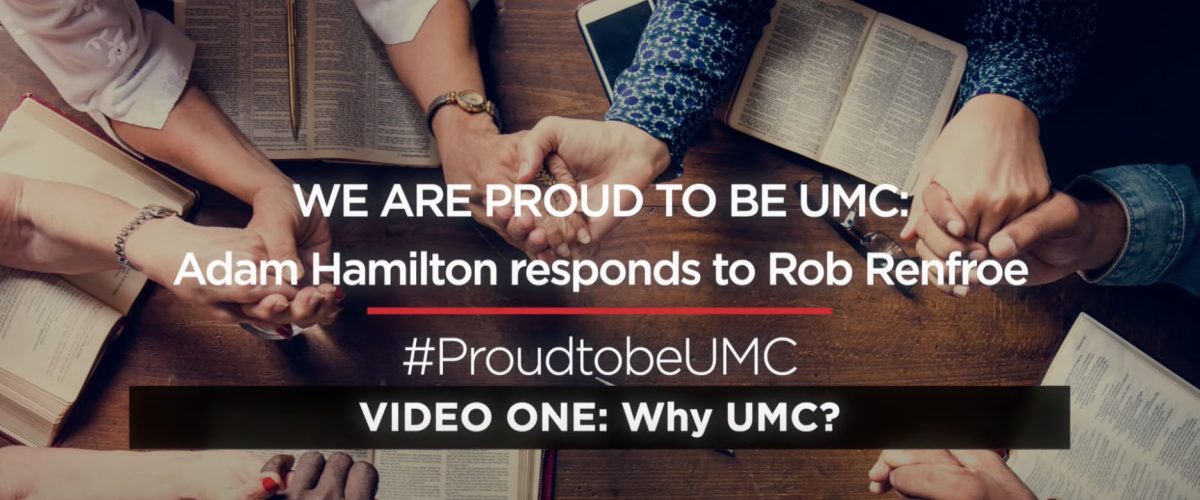Life in The United Methodist Church these days is like riding a seesaw: one moment up and the next down. Sometimes the players bump on the dirt; sometimes they slide off the high end.
However, United Methodists from bishops through well-known clergy to everyday laypeople are proclaiming their reasons for staying in the disintegrating denomination, looking toward what some call “a future with hope.”
United Methodists have increased their public witness — often tagged #BeUMC and #ProudtoBeUMC in social media — after a long, hot summer of misinformation allegedly distributed by Wesleyan Covenant Association supporters soliciting local congregations to join the fledgling Global Methodist Church. The WCA founded the GMC in May after organizers postponed the General Conference, the denomination’s top legislative body, for a third time, pushing back the possibility of concluding a formal separation agreement to 2024.
 Dozens of local congregations have held disaffiliation votes since the GMC was launched, and the information distributed around disaffiliation has been called into question on many occasions. In one instance, a disaffiliation vote at First United Methodist Church in Conroe, Texas, used a ballot critics said used confusing wording, giving church members not a choice of leaving the UMC as church law provides, but leaving the UMC to affiliate with the GMC — combining two actions into one motion. An inquiry posed to Texas Conference Bishop Scott J. Jones, himself a WCA supporter, about whether the ballot was valid according to church law has gone unanswered thus far.
Dozens of local congregations have held disaffiliation votes since the GMC was launched, and the information distributed around disaffiliation has been called into question on many occasions. In one instance, a disaffiliation vote at First United Methodist Church in Conroe, Texas, used a ballot critics said used confusing wording, giving church members not a choice of leaving the UMC as church law provides, but leaving the UMC to affiliate with the GMC — combining two actions into one motion. An inquiry posed to Texas Conference Bishop Scott J. Jones, himself a WCA supporter, about whether the ballot was valid according to church law has gone unanswered thus far.
At the same time, United Methodist bishops who normally avoid commenting on church politics have waded into the fray with vigor since they met in August. Heather Hahn of UM News documented the bishops’ increased activity in a Sept. 28 article. “The bishops share a common message: As churches prayerfully discern where God is calling them, they need to have accurate information,” Hahn wrote.
Several grassroots loyalist groups have sprung up in the past few months to counter misinformation. According to an article by Sam Hodges of UM News, groups go by names such as Stay UMC, Celebrate UMC, That We May Be One, Arkansans Staying United, and Abide South Georgia. Another such group, United Methodist Forward NC, published an open letter Sept. 28 called “Held Together in Christ” urging clergy and laypeople in the North Carolina Annual Conference to remain with the denomination, citing the benefits of being “in connection” for mission and ministry.
Hodges’ UM News colleague Jim Patterson reported Sept. 19 that not all departing churches are joining the traditionalist Global Methodist Church. For instance, some progressive congregations are preferring to remain independent to pursue the kind of LGBTQ inclusion that neither the UMC nor the GMC offers, wrote Darryl W. Stephens, a seminary professor and ordained United Methodist deacon in Lancaster, Pa.
Commentators such as John P. Feagins, pastor of La Trinidad UMC in San Antonio, Texas, have condemned the GMC’s approach as fear tactics. “Explicitly, the Left Behind meta-narrative is found in cynical rhetoric describing an evil post-separation UMC,” Feagins wrote. “Tacitly, this narrative is … felt rather than heard. It is experienced in the fear of social and professional separation.”

Jay Therrell, president of the Wesleyan Covenant Association Florida Chapter.
WCA President Jay Therrell denied to UM News that the organization’s leaders are spreading misinformation. However, Rob Renfroe, president and publisher of the conservative caucus Good News magazine, released a series of YouTube videos titled “Differences that Divide the UMC,” which use arguments similar to what critics denounced. He especially emphasizes what he sees as the UMC’s departure from orthodox Christian doctrine and the anticipated — although not yet realized — acceptance of LGBTQ persons as clergy. Renfroe sits on the WCA’s governing council, and the playlist of his videos gathered more than 72,000 views as of Sept. 28.
A well-known author and speaker, Adam Hamilton, chose to directly confront Renfroe’s videos in his own YouTube series, “#ProudtoBeUMC.” Hamilton takes pains not to criticize Renfroe’s faith, but he refutes Renfroe’s allegations about the UMC with direct factual evidence such as the denomination’s core doctrine, the Articles of Religion, that upholds orthodox views on Jesus Christ.
Hamilton also uses the Methodist theological way of interpreting Scripture through tradition, experience and reason to explain how many mainstream United Methodists read and apply the Bible to their daily lives. In contrast to Renfroe’s playlist, Hamilton’s videos captured around 2,000 views as of Sept. 28.

Adam Hamilton
Hamilton is senior pastor of United Methodist Church of the Resurrection in Leawood, Kan., a multi-campus megachurch near Kansas City that is the largest church in the denomination. He also has launched a ProudtoBeUMC website with resources for congregations considering disaffiliation. Like the bishops, Hamilton and others who want to stay in the UMC are putting a positive spin on the characteristics that dissident forces find objectionable.
Retired clergyman John E. Harnish of Birmingham, Mich., listed five top reasons for his intention to remain in the UMC:
- The Methodist theology of God’s grace working throughout a person’s life.
- The UMC’s global connection via churches on four of the world’s seven continents.
- “Fair share” contributions beyond local churches that fund regional, national and international ministries.
- The “trust clause” through which local church property is held in trust on behalf of the regional unit that provides resources to plant churches.
- The clergy appointment system, through which pastors are assigned by bishops rather than called by congregations.
Unofficial tallies of disaffiliations conducted by UM News, the UMC’s official news agency, and by United Methodist Insight, an independent online journal, found that through the end of September about 700 congregations have disaffiliated since 2019. The total represents about 2.3% of the more than 30,000 U.S. United Methodist churches.
Using data from annual conferences, which must approve disaffiliation votes before congregations can shed their United Methodist connection, observers estimate that somewhere between 10% and 20% of U.S. churches will disaffiliate before the exit process expires Dec. 31, 2023. How many congregations beyond the United States will leave the UMC remains unclear, although a majority of bishops in Africa have said they won’t consider disaffiliations until after the 2024 General Conference.
Meanwhile, the battle continues over who controls the narrative about United Methodism’s future.
Cynthia B. Astle is a veteran journalist who has covered the worldwide United Methodist Church at all levels for more than 30 years. She serves as editor of United Methodist Insight, an online journal she founded in 2011.
Related articles:
In stunning development, United Methodist African bishops repudiate separatist group
Foundry Network offers third alternative to disaffected UMC churches
Events turn against disaffected forces wanting to leave the UMC
As frustration and misinformation mount, United Methodist Church’s reputation takes a beating


